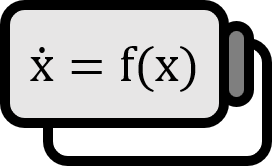Coupled Dynamic Systems
Definition 1
- Let us have a state space $X$. When the adjacency matrix of a network $\Gamma$ with $N$ nodes is denoted by $A$, and the state of node $i \in V \left( \Gamma \right)$ is represented as $x_{i} \in X$, then the following differential equation-based dynamical system is called a Coupled Dynamical System. $$ \dot{x_{i}} = f_{i} \left( x_{i} \right) + \sum_{i=1}^{N} A_{ji} c_{ji} \left( x_{j} , x_{i} \right) \qquad i = 1, \cdots, N $$
- The $f_{i}$ for each node $i$ is called its Evolution.
- The $c_{ji}$ from node $j$ to node $i$ is called the Coupling.
Explanation
Consider the commonly used Euclidean space $X = \mathbb{R}^{p}$, where the state $x_{i}$ of a node represents a vector such as the position of a particle. These vectors follow a vector field created by their respective $f_{i}$, but they can interact with other nodes through the Coupling Term $\displaystyle \sum_{i=1}^{N} A_{ji} c_{ji} \left( x_{j} , x_{i} \right)$.
Two nodes $i$ and $j$ interact with each other through coupling $c_{ji}$ if $A_{ji} = 1$, and they do not interact if $A_{ji} = 0$. Calling these concepts Network Dynamics is justified from this perspective. Especially, if $\Gamma = K_{N}$, meaning if the network is a complete graph, it can be referred to as a Particle Swarm in itself.
Linder. (2021). NetworkDynamics.jl—Composing and simulating complex networks in Julia. https://doi.org/10.1063/5.0051387 ↩︎
